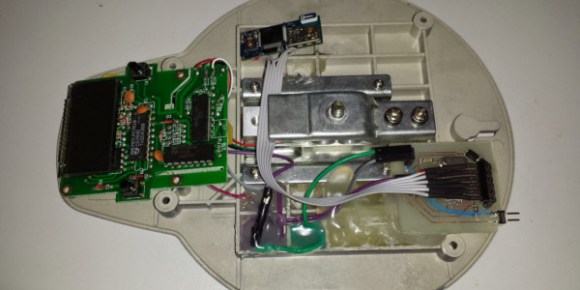
When [Adam] found himself in need of a force meter, he didn’t want to shell out the cash for a high-end model. Instead, he realized he should be able to modify a simple and inexpensive kitchen scale to achieve the results he desired.
The kitchen scale [Adam] owned was using all through hole components on a double-sided PCB. He was able to easily identify all of the IC’s and find their datasheets online. After doing some research and probing around with a frequency counter, he realized that one of the IC’s was outputting a frequency who’s pulse width was directly proportional to the amount of weight placed on the scale. He knew he should be able to tap into that signal for his own purposes.
[Adam] created his own custom surface mount PCB, and used an ATMega8 to detect the change in pulse width. He then hooked up a Bluetooth module to transmit the data wirelessly. These components required no more than 5V, but the scale runs from two 3V batteries. Using what he had on hand, [Adam] was able to lower the voltage with just a couple of diodes.
[Adam] managed to cram everything into the original case with little modification. He is now considering writing an Android application to interface with his upgraded kitchen scale.















The Internet of Fat
Kitchen scales are limited low weight range scales meant to weigh food for cooking and portion control eating. Not to weigh people.
True, but you are the only to mention weigh people, Adam did tell us why he need/wanted this.. There’s a good chance this could be applied to larger scales
What in the hell is a 3V battery?
Usually a coin cell, for instance a CR2032 watch battery.
In the first Month of this year (2014) I had to meassure the weight of something in a prototype. I was kinda suprised that you can get humidity-sensors, light-sensors and all other kind of sensors for the arduino like real cheap. But a weight-sensor was not available anywhere. So I also hacked into a cheap 15€ kitchen scale. It was not really easy and one approach was to sniff on the connector-Pins to the LCD and reverse interprete the value that he showed up. Later on I got help and this guy meassured the loadcell directly with a AD converter and all kind of passive components.
I’m still wondering why something that basic (meassure weight) isnt part on any second experiment kit or at least available besides all those other sensors. I think that meassuring weight of something is kind of an essential part in the field of tinkering. Anyway. Good to see this hack.
Mostly because proper load cells are not terribly cheap. A high quality lab scale costs $2000 – $3000 new. You can get cheap ones but the accuracy is pretty terrible. Plus, you usually want to use more than one to get an accurate reading and then do some software magic to smooth it all out. It’s not amazingly hard to do but it’s not something you can do for $20 and get 100 kg range with 0.01 gram resolution either.
If the results from a scale has good repeatability, it is a matter of using calibrated weight to make it accurate. You can get calibrated weights from China if you can believe their “calibration” and your local gravitation force is the same as theirs.
One interesting thing is that you can get pretty good measurement with volume for liquid using small syringes and water just happens to be around 1 gram per cc (give or take depend on impurities, temperature and how accurate you can measure volume).
I’m curious why the “sniff the LCD pins” approach doesn’t work very well? These scales aren’t perfect but they’re reasonably precise and using the onboard A/D & firmware would allow easy tare compensation and the like.
More to the point, with the huge range of cheap gadgets out there just waiting to be interfaced, why aren’t the display outputs used as kind of a standard signal to be converted to whatever one needs for a project?